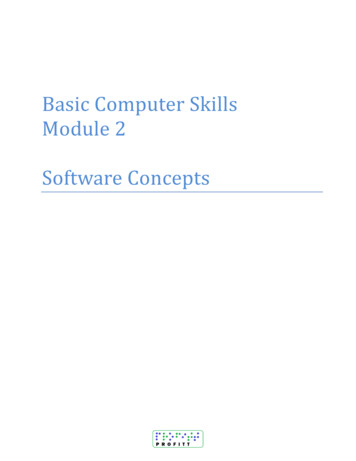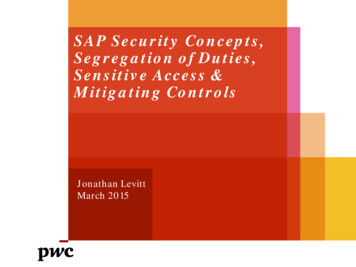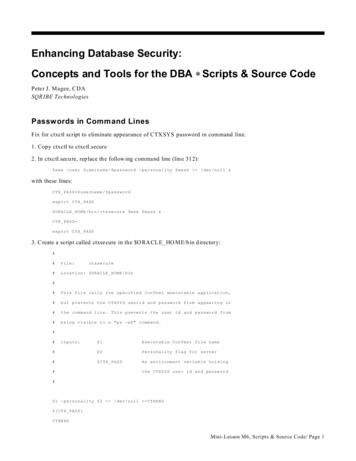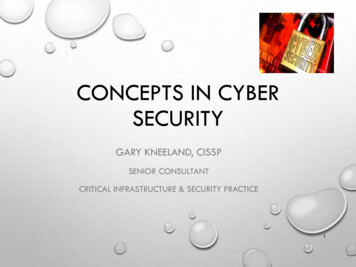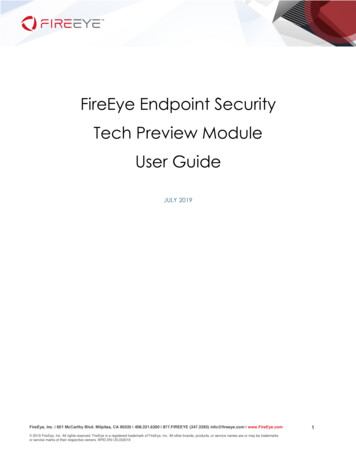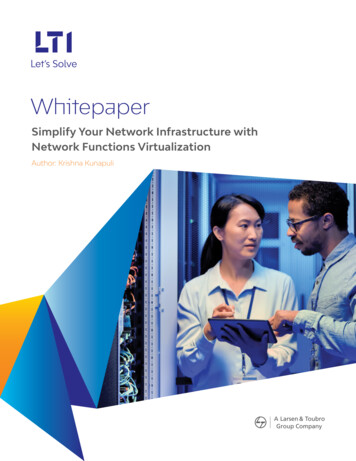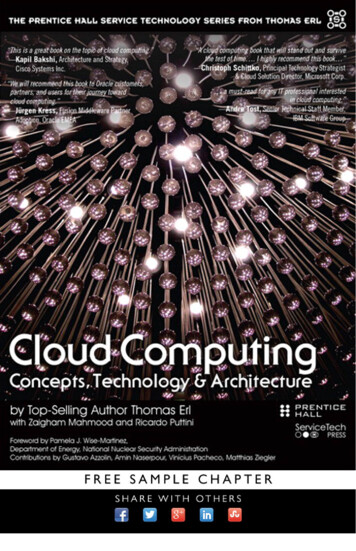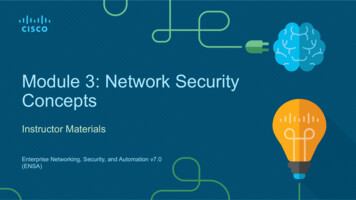
Transcription
Module 3: Network SecurityConceptsInstructor MaterialsEnterprise Networking, Security, and Automation v7.0(ENSA)
Module 3: Network SecurityConceptsEnterprise Networking, Security, and Automation v7.0(ENSA)
Module ObjectivesModule Title: Network Security ConceptsModule Objective: Explain how vulnerabilities, threats, and exploits can be mitigated to enhancenetwork security.Topic TitleTopic ObjectiveCurrent State of Cybersecurity:Describe the current state of cybersecurity and vectors of data loss.Threat ActorsDescribe tools used by threat actors to exploit networks.MalwareDescribe malware types.Common Network AttacksDescribe common network attacks.IP Vulnerabilities and ThreatsExplain how IP vulnerabilities are exploited by threat actors.TCP and UDP VulnerabilitiesExplain how TCP and UDP vulnerabilities are exploited by threat actors.IP ServicesExplain how IP services are exploited by threat actors.Network Security Best PracticesDescribe best practices for protecting a network.CryptographyDescribe common cryptographic processes used to protect data in transit. 2016 Cisco and/or its affiliates. All rights reserved. Cisco Confidential13
Ethical Hacking Statement In this module, learners may be exposed to tools and techniques in a “sandboxed”, virtual machineenvironment to demonstrate various types of cyber attacks. Experimentation with these tools,techniques, and resources is at the discretion of the instructor and local institution. If the learner isconsidering using attack tools for educational purposes, they should contact their instructor prior toany experimentation. Unauthorized access to data, computer, and network systems is a crime in many jurisdictions andoften is accompanied by severe consequences, regardless of the perpetrator’s motivations. It is thelearner’s responsibility, as the user of this material, to be cognizant of and compliant with computeruse laws. 2016 Cisco and/or its affiliates. All rights reserved. Cisco Confidential14
3.1 Current State ofCybersecurity 2016 Cisco and/or its affiliates. All rights reserved. Cisco Confidential15
Current State of CybersecurityCurrent State of Affairs Cyber criminals now have the expertise and tools necessary to take down critical infrastructure andsystems. Their tools and techniques continue to evolve. Maintaining a secure network ensures the safety of network users and protects commercialinterests. All users should be aware of security terms in the table.Security TermsDescriptionAssetsAn asset is anything of value to the organization. It includes people, equipment, resources,and data.VulnerabilityA vulnerability is a weakness in a system, or its design, that could be exploited by a threat.ThreatA threat is a potential danger to a company’s assets, data, or network functionality.ExploitAn exploit is a mechanism that takes advantage of a vulnerability.MitigationMitigation is the counter-measure that reduces the likelihood or severity of a potentialthreat or risk. Network security involves multiple mitigation techniques.RiskRisk is the likelihood of a threat to exploit the vulnerability of an asset, with the aim ofnegatively affecting an organization. Risk is measured using the probability of theoccurrence of an event and its consequences. 2016 Cisco and/or its affiliates. All rights reserved. Cisco Confidential16
Current State of CybersecurityVectors of Network Attacks An attack vector is a path by which a threat actor can gain access to a server, host, or network.Attack vectors originate from inside or outside the corporate network, as shown in the figure. Internal threats have the potential to cause greater damage than external threats because internalusers have direct access to the building and its infrastructure devices. 2016 Cisco and/or its affiliates. All rights reserved. Cisco Confidential17
Current State of CybersecurityData LossData loss or data exfiltration is when data is intentionally or unintentionally lost, stolen, orleaked to the outside world. The data loss can result in: Brand damage and loss of reputation Loss of competitive advantage Loss of customers Loss of revenue Litigation/legal action resulting in fines and civil penalties Significant cost and effort to notify affected parties and recover from the breachNetwork security professionals must protect the organization’s data. Various Data LossPrevention (DLP) controls must be implemented which combine strategic, operational andtactical measures. 2016 Cisco and/or its affiliates. All rights reserved. Cisco Confidential18
Current State of CybersecurityData Loss (Cont.)Data Loss d email or IM messages could be captured and reveal confidential information.Unencrypted DevicesIf the data is not stored using an encryption algorithm, then the thief can retrieve valuableconfidential data.Cloud StorageDevicesSensitive data can be lost if access to the cloud is compromised due to weak securitysettings.Removable MediaOne risk is that an employee could perform an unauthorized transfer of data to a USB drive.Another risk is that a USB drive containing valuable corporate data could be lost.Hard CopyConfidential data should be shredded when no longer required.Improper AccessControlPasswords or weak passwords which have been compromised can provide a threat actorwith easy access to corporate data. 2016 Cisco and/or its affiliates. All rights reserved. Cisco Confidential19
3.2 Threat Actors 2016 Cisco and/or its affiliates. All rights reserved. Cisco Confidential20
Threat ActorsThe HackerHacker is a common term used to describe a threat actorHacker TypeDescriptionWhite Hat HackersThese are ethical hackers who use their programming skills for good, ethical, andlegal purposes. Security vulnerabilities are reported to developers for them to fixbefore the vulnerabilities can be exploited.Gray Hat HackersThese are individuals who commit crimes and do arguably unethical things, but notfor personal gain or to cause damage. Gray hat hackers may disclose a vulnerabilityto the affected organization after having compromised their network.Black Hat HackersThese are unethical criminals who compromise computer and network security forpersonal gain, or for malicious reasons, such as attacking networks. 2016 Cisco and/or its affiliates. All rights reserved. Cisco Confidential21
Threat ActorsThe Evolution of HackersThe table displays modern hacking terms and a brief description of each.Hacking TermScript KiddiesVulnerabilityBrokerDescriptionThese are teenagers or inexperienced hackers running existing scripts, tools, and exploits, tocause harm, but typically not for profit.These are usually gray hat hackers who attempt to discover exploits and report them tovendors, sometimes for prizes or rewards.HacktivistsThese are gray hat hackers who publicly protest organizations or governments by postingarticles, videos, leaking sensitive information, and performing network attacks.Cyber criminalsThese are black hat hackers who are either self-employed or working for large cybercrimeorganizations.These are either white hat or black hat hackers who steal government secrets, gatherState-Sponsored intelligence, and sabotage networks. Their targets are foreign governments, terrorist groups,and corporations. Most countries in the world participate to some degree in state-sponsoredHackershacking 2016 Cisco and/or its affiliates. All rights reserved. Cisco Confidential22
Threat ActorsCyber CriminalsIt is estimated that cyber criminals steal billions of dollars from consumers andbusinesses. Cyber criminals operate in an underground economy where they buy, sell,and trade attack toolkits, zero day exploit code, botnet services, banking Trojans,keyloggers, and much more. They also buy and sell the private information andintellectual property they steal. Cyber criminals target small businesses and consumers,as well as large enterprises and entire industries. 2016 Cisco and/or its affiliates. All rights reserved. Cisco Confidential23
Threat ActorsHacktivistsTwo examples of hacktivist groups are Anonymous and the Syrian ElectronicArmy. Although most hacktivist groups are not well organized, they can causesignificant problems for governments and businesses. Hacktivists tend to relyon fairly basic, freely available tools. 2016 Cisco and/or its affiliates. All rights reserved. Cisco Confidential24
Threat ActorsState-Sponsored HackersState-sponsored hackers create advanced, customized attack code, often usingpreviously undiscovered software vulnerabilities called zero-day vulnerabilities.An example of a state-sponsored attack involves the Stuxnet malware that wascreated to damage Iran’s nuclear enrichment capabilities. 2016 Cisco and/or its affiliates. All rights reserved. Cisco Confidential25
3.3 Threat Actor Tools 2016 Cisco and/or its affiliates. All rights reserved. Cisco Confidential26
Threat Actor ToolsIntroduction to Attack ToolsTo exploit a vulnerability, a threat actor must have a technique or tool.Over the years, attack tools have become more sophisticated, andhighly automated. These new tools require less technical knowledge toimplement. 2016 Cisco and/or its affiliates. All rights reserved. Cisco Confidential27
Threat Actor ToolsEvolution of Security ToolsThe table highlights categories of common penetration testing tools. Notice how some tools are usedby white hats and black hats. Keep in mind that the list is not exhaustive as new tools are always beingdeveloped.PenetrationTesting ToolDescriptionPassword cracking tools are often referred to as password recovery tools and can be used to crack orrecover a password. Password crackers repeatedly make guesses in order to crack the password.Password CrackersExamples of password cracking tools include John the Ripper, Ophcrack, L0phtCrack, THC Hydra,Rainbow Crack, and Medusa.Wireless HackingToolsWireless hacking tools are used to intentionally hack into a wireless network to detect securityvulnerabilities. Examples of wireless hacking tools include Aircrack-ng, Kismet, InSSIDer, KisMAC,Firesheep, and ViStumbler.Network Scanningand Hacking ToolsNetwork scanning tools are used to probe network devices, servers, and hosts for open TCP or UDPports. Examples of scanning tools include Nmap, SuperScan, Angry IP Scanner, and NetScanTools.Packet CraftingToolsThese tools are used to probe and test a firewall’s robustness using specially crafted forged packets.Examples include Hping, Scapy, Socat, Yersinia, Netcat, Nping, and Nemesis.Packet SniffersThese tools are used to capture and analyze packets within traditional Ethernet LANs or WLANs. Toolsinclude Wireshark, Tcpdump, Ettercap, Dsniff, EtherApe, Paros, Fiddler, Ratproxy, and SSLstrip. 2016 Cisco and/or its affiliates. All rights reserved. Cisco Confidential28
Threat Actor ToolsEvolution of Security Tools (Cont.)Penetration TestingToolDescriptionRootkit DetectorsThis is a directory and file integrity checker used by white hats to detect installed root kits. Example tools includeAIDE, Netfilter, and PF: OpenBSD Packet Filter.Fuzzers to SearchVulnerabilitiesFuzzers are tools used by threat actors to discover a computer’s security vulnerabilities. Examples of fuzzersinclude Skipfish, Wapiti, and W3af.Forensic ToolsThese tools are used by white hat hackers to sniff out any trace of evidence existing in a computer. Example oftools include Sleuth Kit, Helix, Maltego, and Encase.DebuggersThese tools are used by black hats to reverse engineer binary files when writing exploits. They are also used bywhite hats when analyzing malware. Debugging tools include GDB, WinDbg, IDA Pro, and Immunity Debugger.Hacking OperatingSystemsThese are specially designed operating systems preloaded with tools optimized for hacking. Examples of speciallydesigned hacking operating systems include Kali Linux, BackBox Linux.Encryption ToolsEncryption tools use algorithm schemes to encode the data to prevent unauthorized access to the encrypted data.Examples of these tools include VeraCrypt, CipherShed, OpenSSH, OpenSSL, Tor, OpenVPN, and Stunnel.VulnerabilityExploitation ToolsThese tools identify whether a remote host is vulnerable to a security attack. Examples of vulnerability exploitationtools include Metasploit, Core Impact, Sqlmap, Social Engineer Toolkit, and Netsparker.VulnerabilityScannersThese tools scan a network or system to identify open ports. They can also be used to scan for knownvulnerabilities and scan VMs, BYOD devices, and client databases. Examples of tools include Nipper, Core Impact,Nessus, SAINT, and OpenVAS 2016 Cisco and/or its affiliates. All rights reserved. Cisco Confidential29
Threat Actor ToolsAttack TypesAttack TypeDescriptionEavesdropping AttackThis is when a threat actor captures and “listens” to network traffic. This attack is also referred to as sniffing orsnooping.Data Modification AttackIf threat actors have captured enterprise traffic, they can alter the data in the packet without the knowledge ofthe sender or receiver.IP Address Spoofing AttackA threat actor constructs an IP packet that appears to originate from a valid address inside the corporateintranet.Password-Based AttacksIf threat actors discover a valid user account, the threat actors have the same rights as the real user. Threatactors could use that valid account to obtain lists of other users, network information, change server andnetwork configurations, and modify, reroute, or delete data.Denial of Service AttackA DoS attack prevents normal use of a computer or network by valid users. A DoS attack can flood a computeror the entire network with traffic until a shutdown occurs because of the overload. A DoS attack can also blocktraffic, which results in a loss of access to network resources by authorized users.Man-in-the-Middle AttackThis attack occurs when threat actors have positioned themselves between a source and destination. They cannow actively monitor, capture, and control the communication transparently.Compromised-Key AttackIf a threat actor obtains a secret key, that key is referred to as a compromised key. A compromised key can beused to gain access to a secured communication without the sender or receiver being aware of the attack.Sniffer AttackA sniffer is an application or device that can read, monitor, and capture network data exchanges and readnetwork packets. If the packets are not encrypted, a sniffer provides a full view of the data inside the packet 2016 Cisco and/or its affiliates. All rights reserved. Cisco Confidential30
3.4 Malware 2016 Cisco and/or its affiliates. All rights reserved. Cisco Confidential31
MalwareOverview of Malware Now that you know about the tools that hacker use, this topic introduces you todifferent types of malware that hackers use to gain access to end devices.End devices are particularly prone to malware attacks. It is important to know aboutmalware because threat actors rely on users to install malware to help exploit thesecurity gaps. 2016 Cisco and/or its affiliates. All rights reserved. Cisco Confidential32
MalwareViruses and Trojan Horses The first and most common type of computer malware is a virus. Viruses requirehuman action to propagate and infect other computers.The virus hides by attaching itself to computer code, software, or documents on thecomputer. When opened, the virus executes and infects the computer.Viruses can: Alter, corrupt, delete files, or erase entire drives. Cause computer booting issues, and corrupt applications. Capture and send sensitive information to threat actors. Access and use email accounts to spread. Lay dormant until summoned by the threat actor. 2016 Cisco and/or its affiliates. All rights reserved. Cisco Confidential33
MalwareViruses and Trojan Horses (Cont.)Modern viruses are developed for specific intent such as those listed in the table.Types of Viruses DescriptionBoot sector virusVirus attacks the boot sector, file partition table, or file system.Firmware virusesVirus attacks the device firmware.Macro virusVirus uses the MS Office macro feature maliciously.Program virusesVirus inserts itself in another executable program.Script virusesVirus attacks the OS interpreter which is used to execute scripts. 2016 Cisco and/or its affiliates. All rights reserved. Cisco Confidential34
MalwareViruses and Trojan Horses (Cont.)Threat actors use Trojan horses to compromise hosts. A Trojan horse is a program that looks useful butalso carries malicious code. Trojan horses are often provided with free online programs such ascomputer games. There are several types of Trojan horses as described in the table.Type of Trojan HorseDescriptionRemote-accessTrojan horse enables unauthorized remote access.Data-sendingTrojan horse provides the threat actor with sensitive data, such as passwords.DestructiveTrojan horse corrupts or deletes files.ProxyTrojan horse will use the victim's computer as the source device to launch attacks and perform otherillegal activities.FTPTrojan horse enables unauthorized file transfer services on end devices.Security software disablerTrojan horse stops antivirus programs or firewalls from functioning.Denial of Service (DoS)Trojan horse slows or halts network activity.KeyloggerTrojan horse actively attempts to steal confidential information, such as credit card numbers, byrecording key strokes entered into a web form. 2016 Cisco and/or its affiliates. All rights reserved. Cisco Confidential35
MalwareOther Types of MalwareMalwareDescriptionAdware Adware is usually distributed by downloading online software. Adware can display unsolicited advertising using pop-up web browser windows, new toolbars, or unexpectedly redirect awebpage to a different website. Pop-up windows may be difficult to control as new windows can pop-up faster than the user can close them.Ransomware Ransomware typically denies a user access to their files by encrypting the files and then displaying a message demanding aransom for the decryption key. Users without up-to-date backups must pay the ransom to decrypt their files. Payment is usually made using wire transfer or crypto currencies such as Bitcoin.Rootkit Rootkits are used by threat actors to gain administrator account-level access to a computer. They are very difficult to detect because they can alter firewall, antivirus protection, system files, and even OS commands toconceal their presence. They can provide a backdoor to threat actors giving them access to the PC, and allowing them to upload files, and install newsoftware to be used in a DDoS attack. Special rootkit removal tools must be used to remove them, or a complete OS re-install may be required.Spyware Like adware but, used to gather information about the user and send to threat actors without the user’s consent. Spyware can be a low threat, gathering browsing data, or it can be a high threat capturing personal and financial information.Worm A worm is a self-replicating program that propagates automatically without user actions by exploiting vulnerabilities in legitimatesoftware. It uses the network to search for other victims with the same vulnerability. The intent of a worm is usually to slow or disrupt network operations 2016 Cisco and/or its affiliates. All rights reserved. Cisco Confidential36
3.5 Common NetworkAttacks 2016 Cisco and/or its affiliates. All rights reserved. Cisco Confidential37
Common Network AttacksOverview of Common Network Attacks When malware is delivered and installed, the payload can be used to cause a varietyof network related attacks.To mitigate attacks, it is useful to understand the types of attacks. By categorizingnetwork attacks, it is possible to address types of attacks rather than individualattacks.Networks are susceptible to the following types of attacks: Reconnaissance Attacks (prieskumnicke) Access Attacks (ziskavajuce vstup) DoS Attacks 2016 Cisco
Vulnerability Scanners These tools scan a network or system to identify open ports. They can also be used to scan for known vulnerabilities and scan VMs, BYOD devices, and client databases. Examples of tools include Nipper, Core Impact, Nessus, SAINT, and OpenVAS
